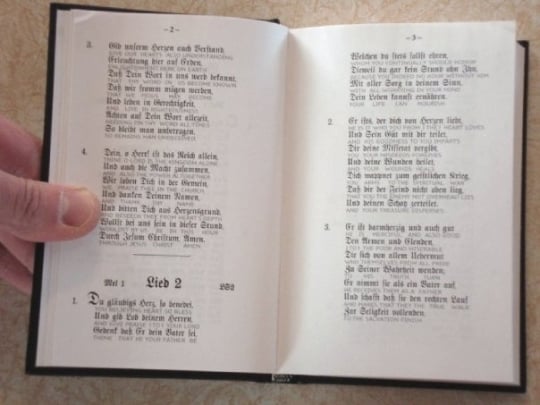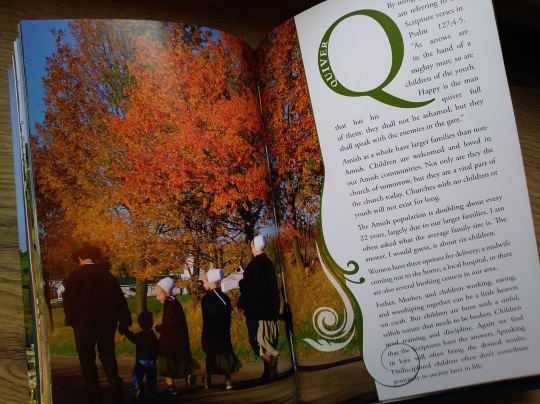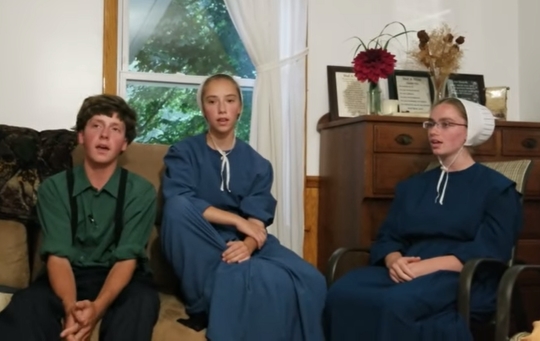Who owns Amish community goods?
Reader Brad of the Brethren recently raised the question of common ownership of goods among the Amish.
Amish are not like Hutterites where the vast majority of property is shared in common. Amish individuals own private property like anyone else. Amish households operate independently in a commercial sense, though within a web of church and community support galvanized in times of need.

But what about the handful of goods used collectively in Amish communities? And what about schools? I passed these questions along to an Amish friend who shares an answer from the perspective of the large northern Indiana settlement.
Below, he addresses ownership of churchwagons, cemeteries (though he says he has limited knowledge on that topic, I think what he shares is worth reading anyway), schoolhouses, and one other item which sometimes comes in very handy. Reproduced in full here:
Erik,
You were correct in thinking the church only owned the bench wagon and its contents. But it’s not uncommon if 1 to 4 church districts split the cost of a tent or two and assign 1 person to take care of it. The tents are used for church, reunions, funerals and etc… Right now I can’t think of anything else that the church owns.
 Cemeteries are generally owned by the public or county. I actually don’t know. But there are very few Amish owned cemeteries that I know of and they are quite small generally on a big farm. But it is common for all the surrounding church districts to maintain the local cemetery. I probably shouldn’t have written this paragraph because I really hardly know anything about this subject.
Cemeteries are generally owned by the public or county. I actually don’t know. But there are very few Amish owned cemeteries that I know of and they are quite small generally on a big farm. But it is common for all the surrounding church districts to maintain the local cemetery. I probably shouldn’t have written this paragraph because I really hardly know anything about this subject.
In our community schoolhouses aren’t built on donated land that I am aware of but it probably happens here and there as our community is quite big. A group of people (normally from one to four church districts) purchase a few acres, come up with a school name, get a tax number and at that point operates as a non-profit business owned by itself with parents paying a certain amount of tuition per child. This money pays teachers, maintenance, books, and the mortgage and building costs.
Adios, Amigo or should it be Later, Graber
As with most things Amish, some practices are more typical of certain communities. So you’re likely to see variations and quirks across the 450+ Amish communities (for instance, the source and usage of land Amish schools are built upon may vary–as seen in this case of school grounds transforming by the season in one community). But this should give you the general picture, and specifics on how things work in one of the largest Amish settlements.
Church Tents
As for tents, as noted above Amish sometime do have church outside underneath them. The first place I remember encountering this was in fact our Amish contributor’s community of northern Indiana.
If you’re curious, another (non-Amish) resident of the area shares the following:
“…the Amish do hold services outside in tents when a house / shop is not well suited or available for the service. …’s for example have their service outside in a tent because the house doesn’t have enough space for the service and his shop is typically full of equipment and parts. … …s in Arthur is another tent service I have attended. They lived in a mobile home and did not have a shop available for use. These families tend to take a church rotation in the summer when the weather is warm.”







Thanks
Very interesting article, Erik. Thanks.
Glad you like it Don, and the biggest thanks go to Floyd, the author. Just confirmed I have authorization to attach a name to this letter 🙂
Belle Center Churches' properties
I found this article interesting and asked my son, Mark, who is Amish and a part of the Belle Center Amish Community how they worked this out.
Mark said that at Belle Center each church district has its own bench wagon, benches, hymnals, etc. However, in the case of weddings and funerals all of the community’s benches may be needed for the one occasion and are all brought together. The community has no church or community building.
Because Belle Center is kind of isolated and all four church districts operate under one ordnung the schools are considered outreaches of the Church. Each school has its own school board and are listed for tax purposes under the church. The Belle Center Amish Cemetery is on the property of the west district school, Richland Christian School. It is right behind the school. When Mark first visited the community back in 1986 there wasn’t one grave in the cemetery. But time goes on. The generation that founded the community are slowly passing away. The community has had six deaths in the last nine months, alone. Anyway, Mark says they have taken down the back fence and the cemetery will have to be expanded. The families in the west district take turns mowing the schoolyard and mow the cemetery, as well.
Church property, continued
I forgot to mention that Mark said that the Belle Center community, under the church, also owns a refrigeration wagon. It is sort of like a refrigerated, moveable pantry. It is used, especially for weddings. Mark says he has been in it and it is hard to resist a whole wagon with shelves loaded with pies. Also, there is a wedding wagon. It is loaded with folding tables. It is used for weddings and funerals.
Pies delivered
Nice to hear that Belle Center has expanded to 4 districts Don, I think Mark may have mentioned that was in the works on one of my last visits.
That “pie wagon” ought to go around like the ice cream man. Maybe a new business idea 🙂
What about things like threshing machines? In the (non-Amish)
community where I grew up, “threshing rings” were common until about the late 1950’s when farmers started to use combines. A “threshing ring” was a group of farmers who lived in the same area who would go together and buy a threshing machine, then help each other with their threshing. The threshing machine would be taken from farm to farm during harvest time. I see a lot of threshing being done in the summer in the Swartzentruber community I often visit. I’ll ask next time I’m there about who owns the threshing machine — an individual or the community.
Who owns the threshing machine among Amish?
Great question Al. This study of Geauga County Amish mentions the threshing machine being owned by a threshing circle consisting of 2-6 farms. http://www.joe.org/joe/2004october/rb8.php
Don Curtis commented about two threshing rings in Mark’s Belle Center OH community, which each own an antique thresher https://amishamerica.com/amish-threshing-or-thrashing-oats/#comment-32206
One Amishman is cited as the owner of the machine in this 2011 piece on Amish in I believe Van Buren County, IA: http://www.ottumwacourier.com/local/x2021664254/An-old-fashioned-harvest/print
This 1988 article on Kalona Amish mentions one farmer owning a threshing machine: http://articles.chicagotribune.com/1988-08-09/news/8801210505_1_amish-farmers-anabaptist-movement-jonas-miller
As usual might be different in different places. Would be curious what answer you get from your Swartzentruber visit.
Always more to think about, relating to the Amish.
Interesting to hear your son’s input, Don. I saw a photo of one of those Amish wedding “vans”—QUITE impressive. I don’t know that I’d be able to withstand the temptation of being near shelves laden with homemade pies, either. There is no doubt in my mind that I’d weigh considerably more than I already do (I’m no lightweight) if I were Amish!
I’m wondering how old some of those church benches might be…
Alice Mary
Thoughts on Schooling
This is very informative. I do have a question about the schools, though. Would the school-teacher be trained to teach (I don’t think so), and are they required by law to have a certain amount of schooling? If not trained, would the children be qualified as home-schooled, public schooled, or private schooled? I’ve been in both, but mainly homeschool, so this topic is interesting to me. In homeschooling, the “teacher” does not need an education. You don’t even need an actual textbook! By law, you need a certain number of hours or days of “school,” but if audited, you just have to have a sample of work that a certified teacher says shows adequate progress.
I’m sure that there are homeschooled Amish children. Most definitely if their parents are “pioneers” in a county.
plainpathwaytohim.wordpress.com
plainpathwaytohim.tumblr.com
In Christ,
Ada
Amish cemeteries
Apologies for this late comment but if there are few Armish owned cemeteries, where are they generally buried?
Amish Cemeteries
I asked my son, Mark, about the cemeteries. Belle Center has one cemetery for the community. It is located behind the west schoolhouse. He says that in many other communities the cemeteries are on private land and are exclusive for family members. In large Amish communities some of the Amish cemeteries may have been taken over by the township or county. It varies by community.
Amish Houses
Who owns the individual houses that the Amish live in? Do they purchase it and the land? Can they pass it on to their heirs?